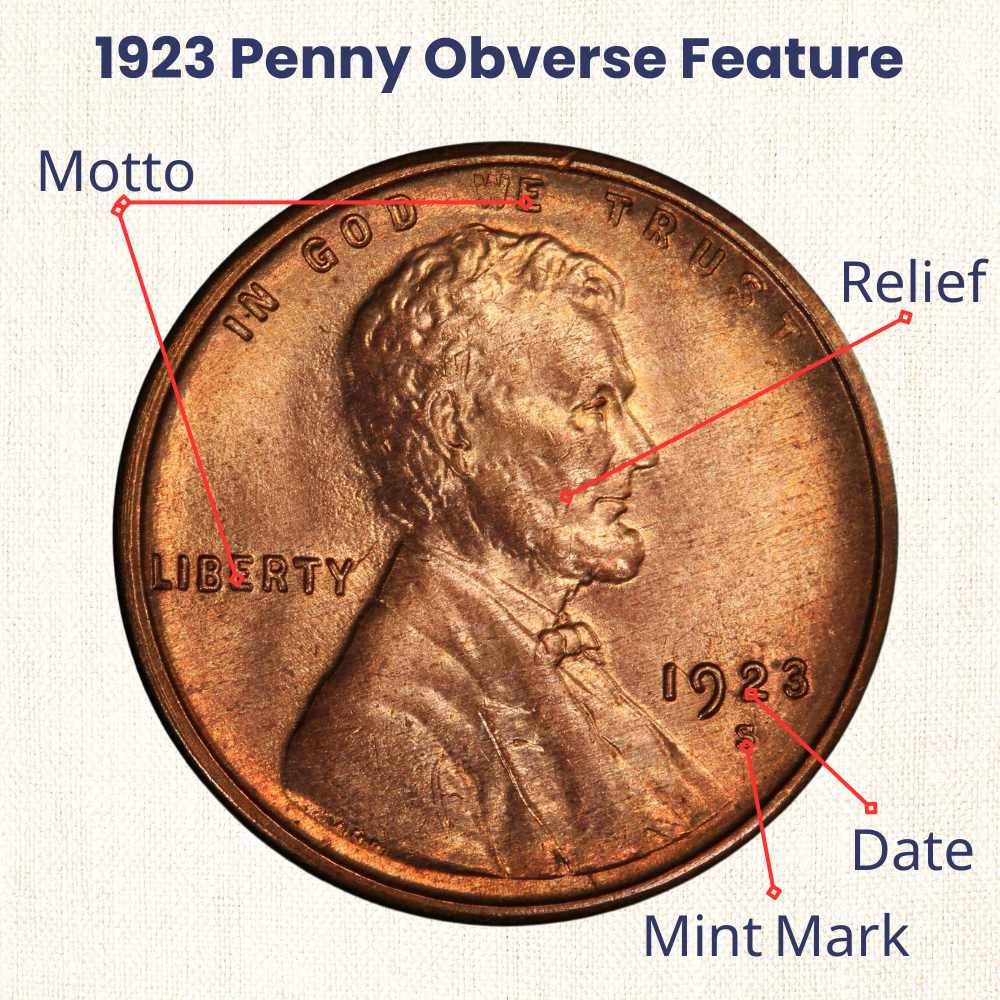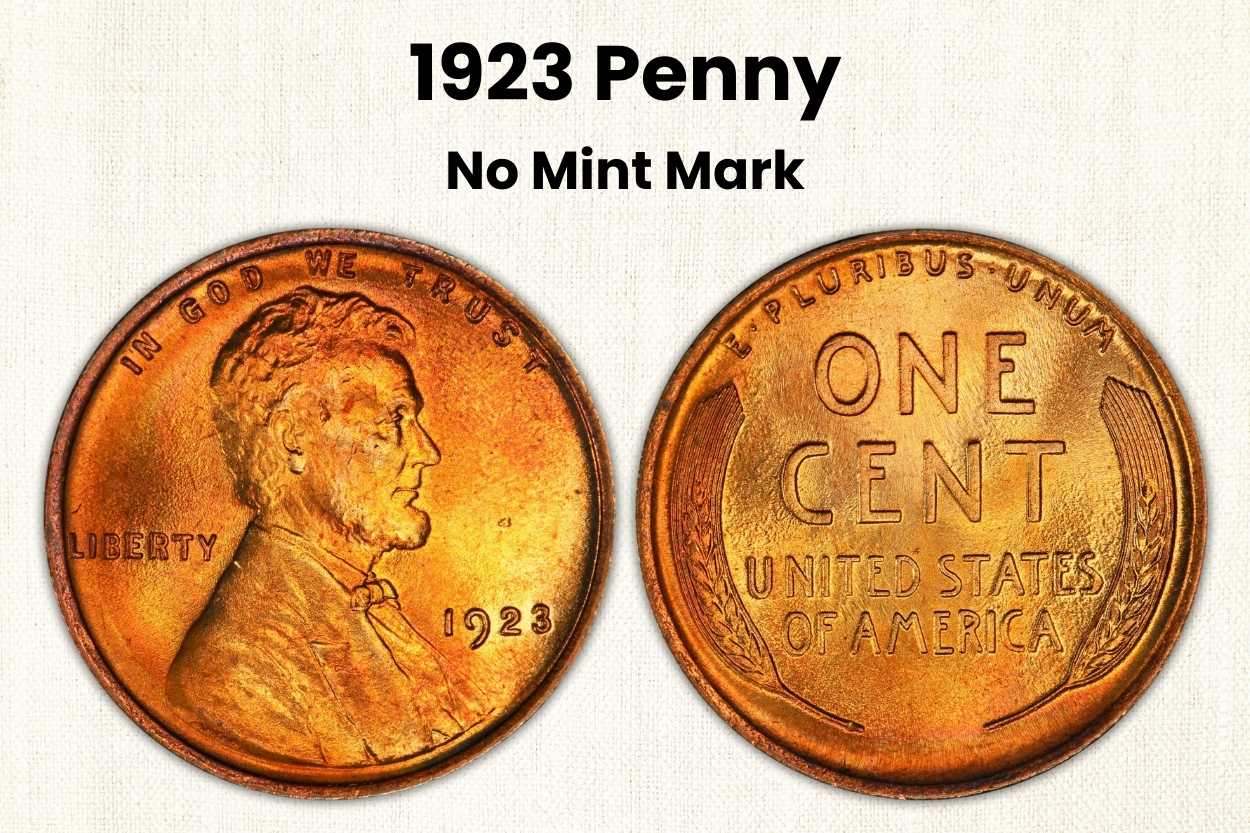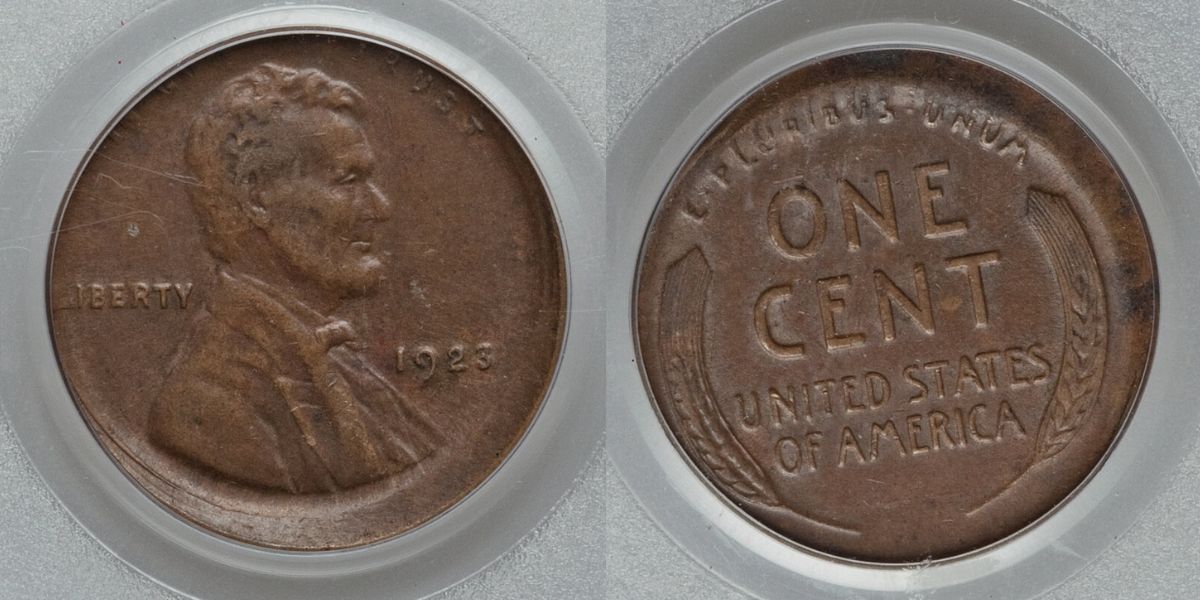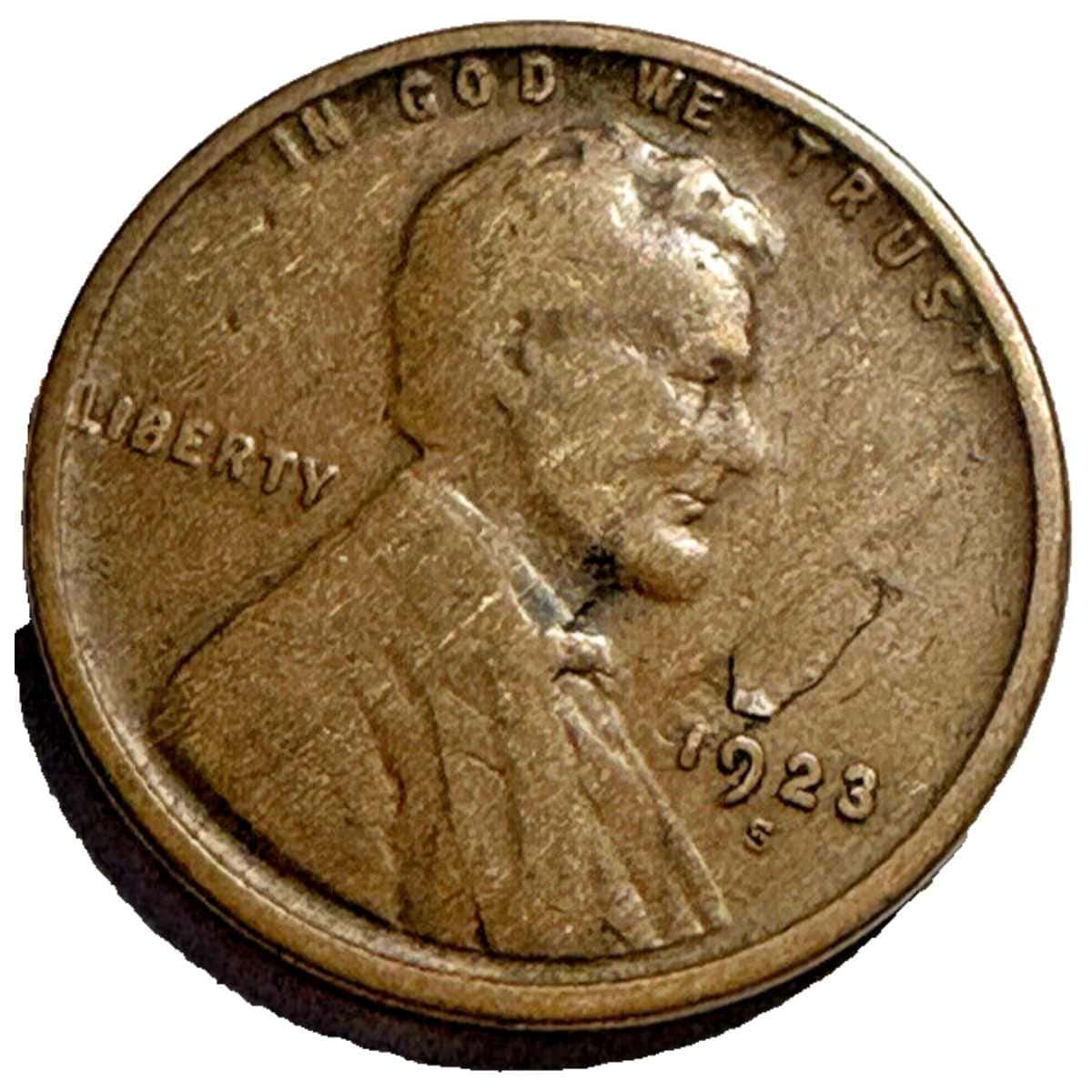The 1923 Penny has been in circulation for 100 years. Its long existence makes it desirable to collectors despite the similar obverse design in the modern penny we know. Aside from this, it offers a higher value for those looking to sell a piece or invest in a pristine condition coin.
In this article, we’ll talk about the 1923 Penny Value and its six varieties. Plus, a list of error coins you may purchase in coin selling platforms.
1923 Penny Value Summary
The 1923 Penny is among the older dates of the Lincoln Penny (Wheat Reverse) series. With that, its base price sells a few cents higher than its Memorial and Shield Reverse successor. As per our research, a no-mint mark 1923 Penny can sell for $0.50 to $13.50 for circulated conditions. In uncirculated conditions, you can expect an estimated value of $15 to $8,400, depending on the coin color.
Aside from the no-mint mark coins from Philadelphia, San Francisco also contributed to producing this issue. A 1923-S Penny in circulated condition outset at $2 up to $225, while uncirculated conditions can go from $230 to $28,750.
Later, we’ll lay out the estimated value for each grade. But for now, here’s a quick overview of the varieties with their estimated value.
| 1923 Penny Summarized Value Chart | |||
| Mint Location | Mintage | Coin Variety | Estimated Value |
|
Philadelphia |
74,723,000 |
1923 1C MS BN | $0.50-$210 |
| 1923 1C MS RB | $37.50-$485 | ||
| 1923 1C MS RD | $53-$8,400 | ||
|
San Francisco |
8,700,000 |
1923-S 1C MS BN | $2-$1,400 |
| 1923-S 1C MS RB | $435-$3,100 | ||
| 1923-S 1C MS RD | $460-$28,750 | ||
1923 Penny History

The Lincoln penny first appeared in circulation in 1909, after Theodore Roosevelt stipulated to revitalize the US coinage. In particular, he wanted to focus on the cent and the other four gold pieces. Augustus Saint-Gaudens initially did the redesign for these coins. However, the renowned sculptor succumbed to death before he finished the work for the cent.
In late 1908, Victor David Brenner took over and made a design to commemorate the centennial birth of Abraham Lincoln. It was a break from the numismatic norms, as they never featured an actual person before. Many went against it, but the critics were no match for Roosevelt’s interest in honoring his fellow Republican.
Philadelphia, San Francisco, and Denver collaborated in minting the new Lincoln pennies. But in 1923, the latter coin facility temporarily stopped its production of the one-cent denomination. Denver focused on silver and gold coinage. Meanwhile, Philadelphia had to double its production compared to the previous year to fill in the loss.
Both Mints rolled altogether over 83 million pieces of the 1923 Penny. All these are regular strike coins since the Lincoln Penny (Wheat Reverse) series only has Proof for dates 1909 to 1916, 1936 to 1942, and 1950 to 1958.
1923 Penny Coin Information
- Category: Lincoln Penny, Wheat Reverse (1909-1958)
- Face Value: One Cent
- Obverse-Reverse Designer: Victor David Brenner
- Metal Composition: 95% Copper, 5% Tin and Zinc
- Weight: 3.11 grams
- Diameter: 19.00 millimeters
- Edge: Plain

The Lincoln Penny (Wheat Reverse) features a lot of firsts in its design. And all of these can be found on the obverse side of the coin. One is the portrait of Lincoln facing to the right, the first living person on a US coin. Second is the motto IN GOD WE TRUST, which was non-existent from its predecessor. Then, situated on the right-hand field is the mint year, 1923.

Turning on the reverse are the iconic wheat stalks flanked around the words ONE CENT and UNITED STATES OF AMERICA. Lastly, on the top is the motto, E PLURIBUS UNUM.
1923 Penny Varieties
The 1923 Pennies are categorized based on their color and the presence of a mint mark. Those coins without mint marks automatically trace their origin from Philadelphia. On the other hand, those with an S mark on the obverse side are from San Francisco.
These coins are further identified by their color (aside from their numerical grade). In total, there are three color-coin grading:
- Red (RD): displays at least 95% of its original red copper color.
- Red Brown (RB): have at least 5% to 95% red color preserved.
- Brown (BN): exhibits less than 5% of its original red copper color.
If you want to learn more about color-coin grading, you can watch this video:
1923 No Mint Mark Penny Value

The 1923 Penny has a high mintage of over 74 million coins. But still, it is way below other P-mint dates from the 1920s. Most of these coins today are in circulated condition and can sell for $0.50 to 13.50.
Mint State grades from 60 to 66 are also plentiful in all colors. But superb examples, like MS 67 and 68 RD, are rare and often demand thousands of dollars.
A 1923 Penny in MS 60 to 66 BN grade is valued at $15 to $210. However, it can jump at least 15 dollars higher for those with good to excellent red color preservation. Currently, an MS 62 to 66 RB sits at around $37.50 to $485, while an MS 62 to 67 RD can go from $53 to $8,400.
A known coin grading service recorded a 1923 Penny in MS 68 RD, although it never appeared in any auctions. The MS 67 RD remained the highest record, which sold for $11,500 at Stack’s Bowers in 2006.
| 1923 No Mintmark Penny Value Chart | |||
| Coin Grade | MS BN | MS RB | MS RD |
| PO-1 to XF-40 | $0.50-$7 | / | / |
| AU-50 to AU-58 | $9.50-$13.50 | / | / |
| MS 60 | $15 | / | / |
| MS 61 | $17.50 | / | / |
| MS 62 | $22 | $37.50 | $53 |
| MS 63 | $29 | $55 | $80 |
| MS 64 | $53-$65 | $90 | $110-$150 |
| MS 65 | $125 | $200-$250 | $500-$600 |
| MS 66 | $210 | $485 | $1,375-$1,700 |
| MS 67 | / | / | $1,900-$8,400 |
1923-S Penny Value

San Francisco made over 8 million pieces of 1923-S Penny. It is a small mintage compared to the other S-marked pieces in the series, making it somewhat valuable.
But concerning quality, most of the 1923-S Penny was coined from worn dies. Incomplete details, distorted design, and shallow mint marks are some of the features these varieties display. Coins with the original red color are extremely rare since most have a brassy than copper color. Another problem is that it has “woodgrain” toning because of improper alloy mixing.
A Poor to Extremely Fine grade is worth $2 to $65, while an About Uncirculated grade ranges around $100 to $225. As you can see, it is higher in value than the no-mintmark. It is because well-worn examples got hoarded in 1935 before they completely disappeared from circulation in 1960.
For uncirculated conditions, you can get an MS 60 to MS 65 BN for $230 to $1,400. For MS 62 to MS 65 RB, the value ranges between $435 to $3,100. But if you want to get the best piece, there are three things you need to consider:
- It must be fully-struck.
- Get a sample that is as red as possible.
- Find those with few carbon spots (tiny black spots).
If you find a 1923-S Penny with such detail, you can expect it to command at least $460 to $28,750.
| 1923-S Penny Value Chart | |||
| Coin Grade | MS BN | MS RB | MS RD |
| PO-1 to XF-40 | $2-$65 | / | / |
| AU-50 to AU-58 | $100-$225 | / | / |
| MS 60 | $230 | / | / |
| MS 61 | $265 | / | / |
| MS 62 | $315 | $435 | / |
| MS 63 | $485 | $975-$1,200 | $460 |
| MS 64 | $650-$800 | $1,625-$2,400 | $1,600 |
| MS 65 | $1,400 | $3,100 | $2,850-$3,300 |
| MS 66 | / | / | $28,750 |
1923 Penny Error Coins
There are a couple of 1923 Penny errors that add uniqueness and excitement to the piece. If you feel like adding one to your collection, here are some types you should know.
1923 Penny Uncentered Broadstrike Error

An uncentered broadstrike is a type of striking error. It occurs when a planchet is poorly centered and struck out of the collar (hard ring steel that serves as a wall for the coin). As a result, the coin expands to a larger diameter than the original requirement. Coins with this error must display a complete design on both sides. But if it’s missing an element, it is considered an off-center strike error.
An uncentered broadstrike can value anywhere between $5 to $50.
1923 Penny Partial Collar Strike Error

A Partial Collar Strike error happens when the striking press malfunctions. It leads to a planchet positioned slightly off the collar die. As the coin gets struck, parts of the planchet are forced into the collar die, constraining the metal flow. However, the remaining metal freely expands beyond the boundary of the die. As an effect, the circumference of the coin displays a stepped appearance.
Partial Collar errors are common but rare when compared with planchet errors. It can sell for more or less $30 for circulated conditions and $100+ for uncirculated conditions.
1923 Penny Struck-Through Error

A struck-through error happens when something gets between a die and a planchet. It could be grease, cloth, or even a single thread. The extent can be minor or major, but generally, the unique ones get the most value. A thread, for example, is way less common than a grease affecting the coin’s design. It can sell for over $100 to $200, depending on the condition.
1923 Penny Clipped Planchet Error

A metal strip goes through machinery to produce planchets for new coins. But, when a strip isn’t fed far enough along the previous holes, the punches overlap and cause an irregularly shaped coin. Another probable reason is when the planchet gets stamped from the end of a metal strip, creating a straight clip type of error.
A Lincoln Penny with this error can sell for a starting price of $5. But coins in mint state and graded can range from $50 to 350+.
1923 Penny Lamination Error

A lamination error is a planchet defect caused by metal contamination during mixing. It may result in discoloration, uneven coin surface, or most commonly, peeling. The peeling or separation effect makes people mistake it for a split planchet. But note that this error occurs only superficially and is less dramatic.
This type of error can sell at around $15 to $20.
Grading The 1923 Penny
Aside from the color-coin grading, you should know how to assess your coin based on its current state. So, here, we’ll walk you through four grading condition and their descriptions.
Uncirculated
Uncirculated conditions are well-preserved and never entered circulation. As a result, it has minimal to no trace of wear to its surface, and the original luster is still intact. Lincoln’s cheek and beard on the obverse side have visible shine. Then, the grain on the wheat stalks on the reverse remains lustrous.
Extremely Fine
A coin in this condition spent a short time in circulation. Wear starts to show in the highest points of the design. The bright red copper luster also begins to fade and turns into light tan or brown. But some small details remain intact, like the jawline and the hair curls at the back of the ear. Meanwhile, the grains on the wheat stalk are still complete and visibly separated.
Fine
A fine-condition coin is moderately worn, with evident wear on both sides. But despite this, Lincoln’s hair remains detailed, except in high spots. The cheeks and jaws are flattened, while a smooth area appears near the ear. On the reverse side, the grains start to emerge and flatten. Although, the bottom of the stalk is still raised and distinct.
Good
A good-condition coin shows a merging from the hair above the ear through the cheek and jaw. The folds in the coat and the top part of the hair remained detailed. With the reverse, lines at the tip of the stalks have merged, and most of the grains are now missing. Although, occasional details on the bottom of the stalks are still evident. Lastly, the inscription is still distinct. However, the motto E PLURIBUS UNUM somewhat merges at the top of the rim.

Jenson is a professional numismatist, a dedicated coin collector, a graduate of the College of Business at Oregon State, a life member of the American Numismatic Association (ANA), and an overall coin nerd. He is the founder of Coin Value List.
